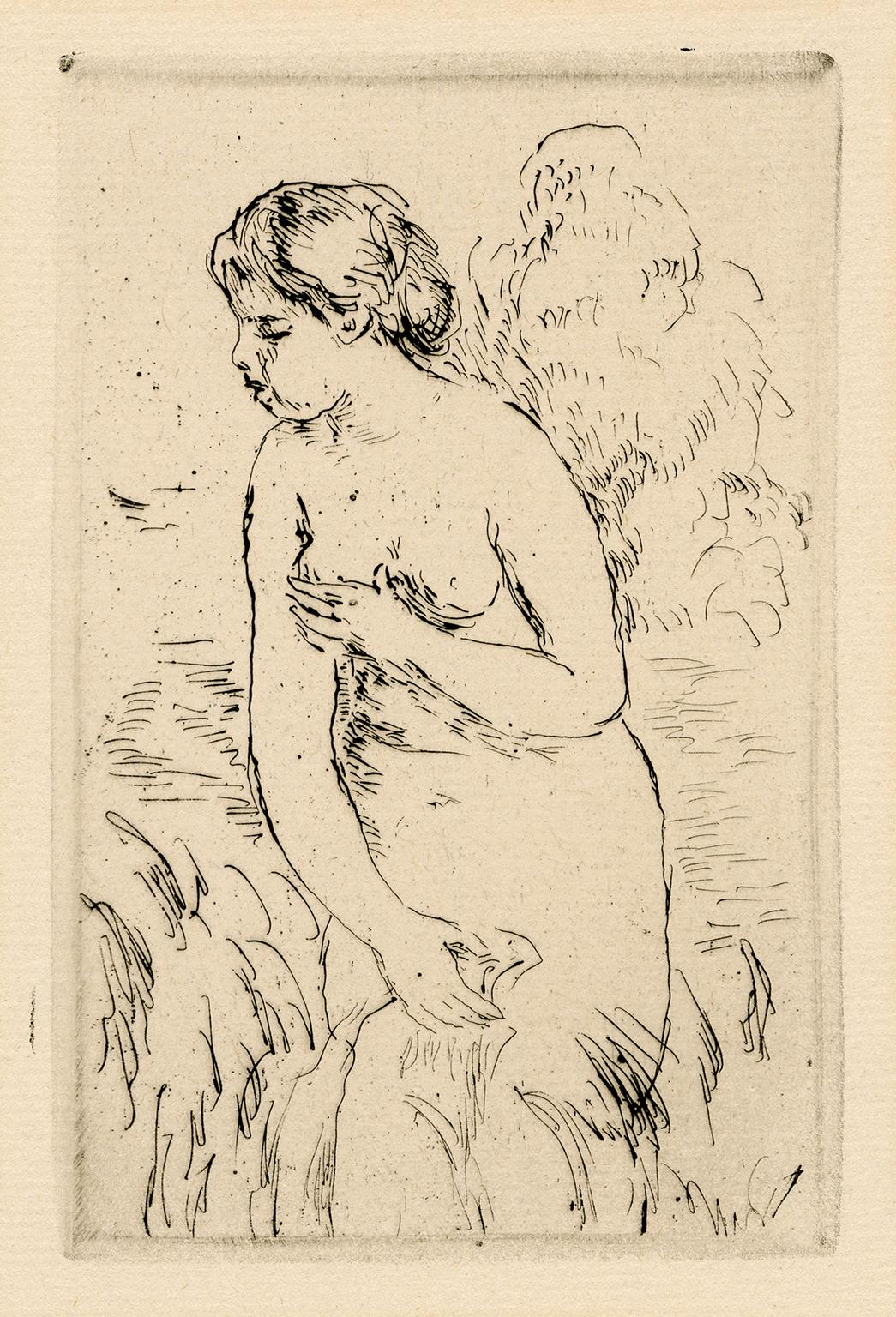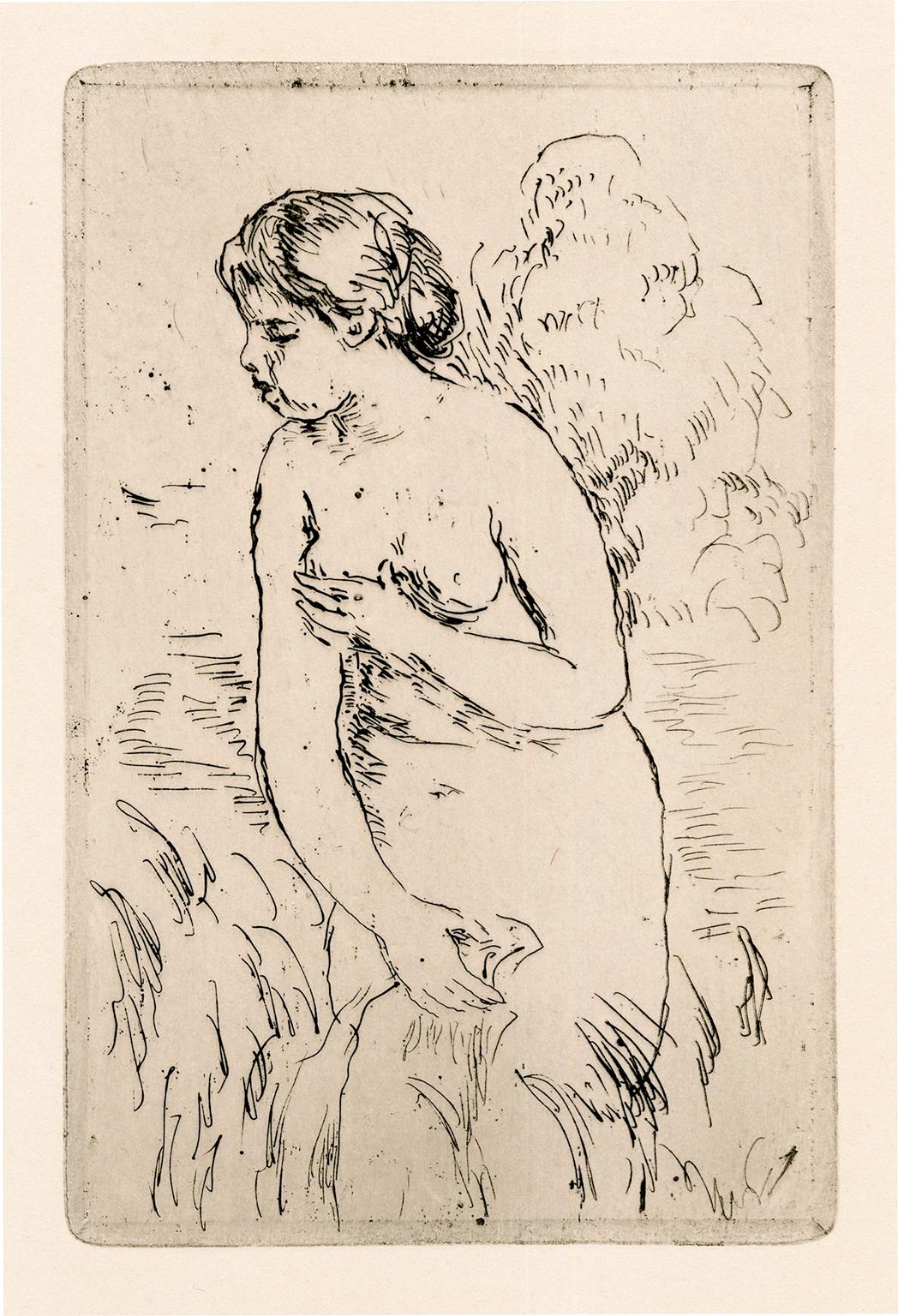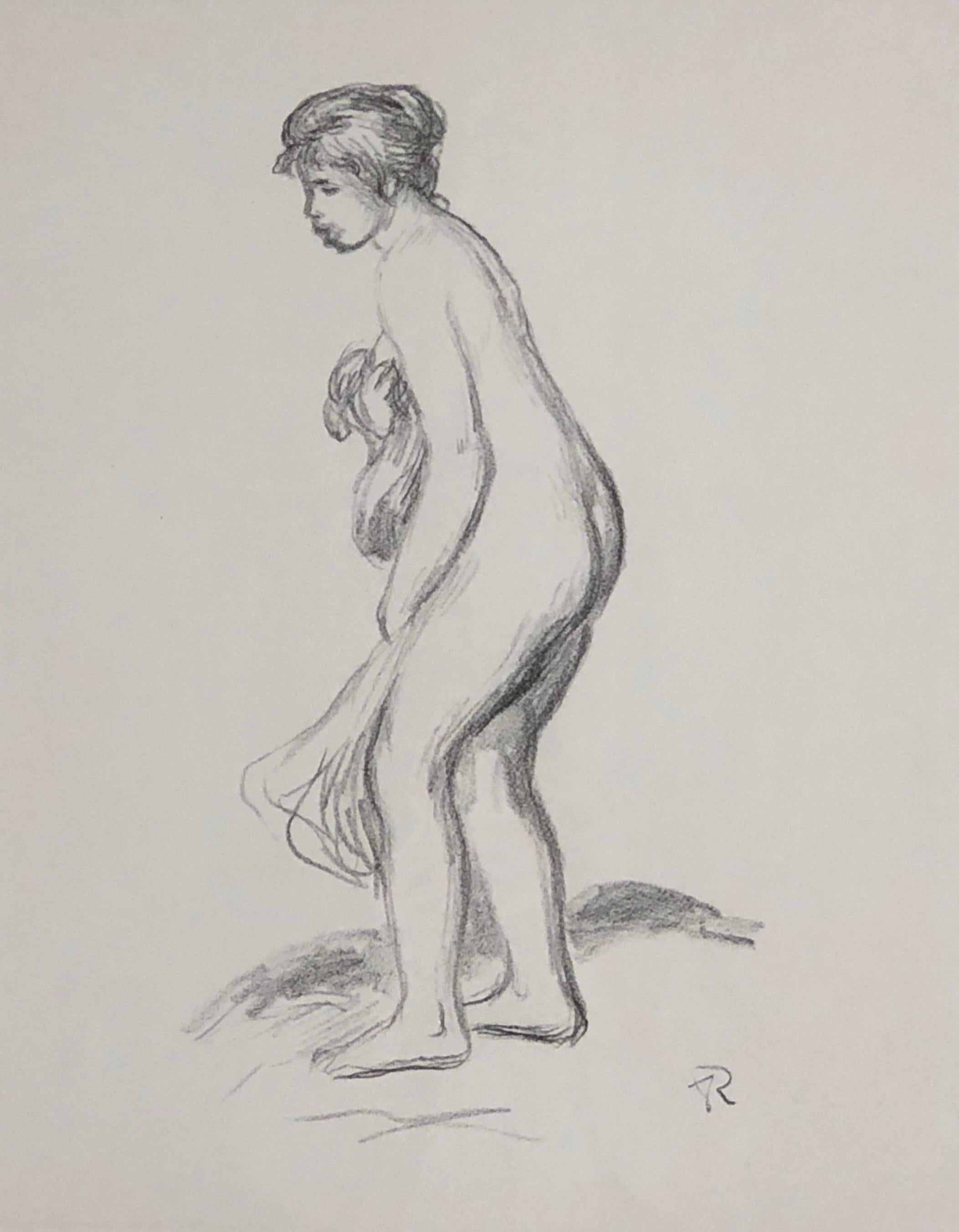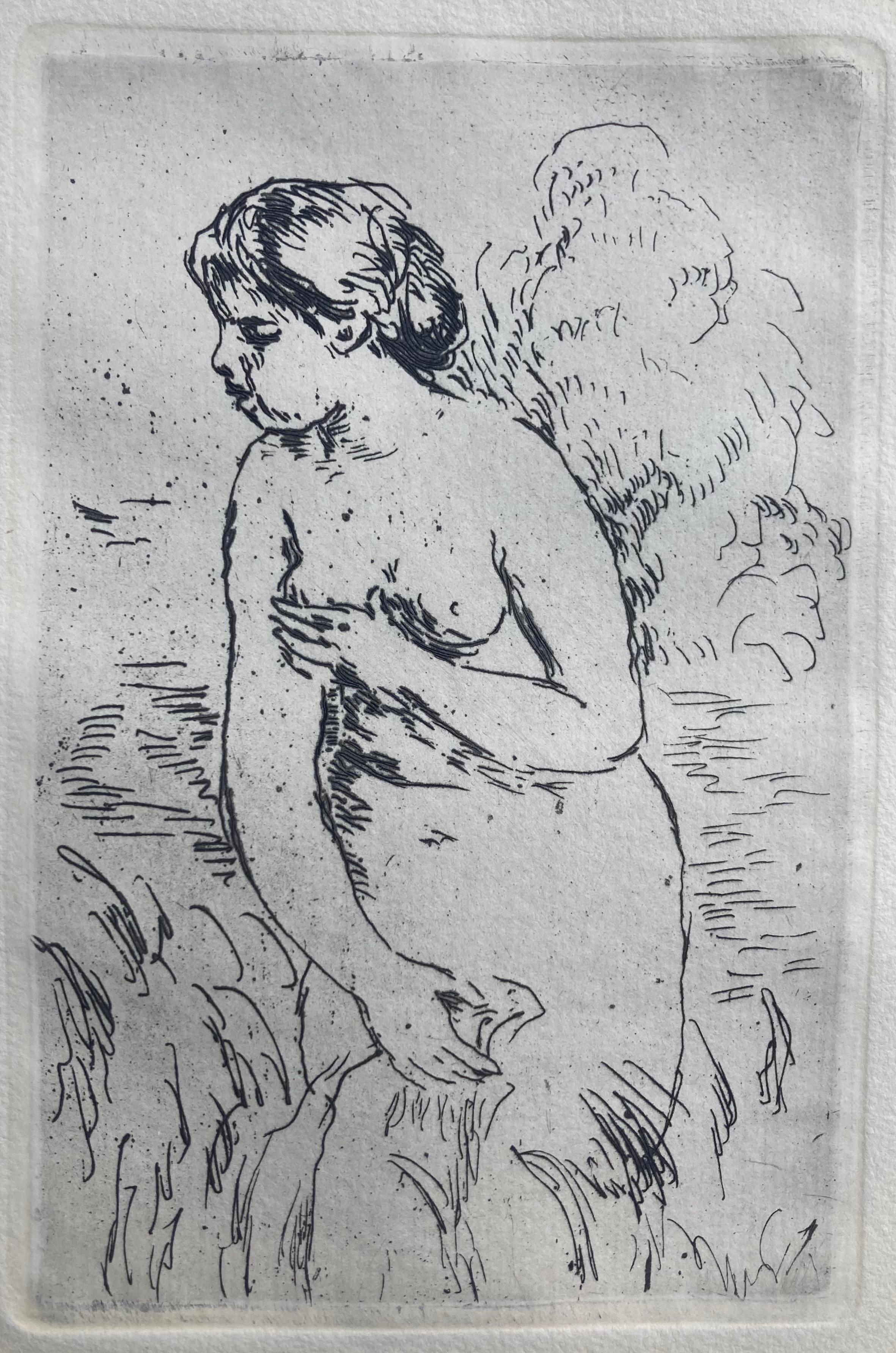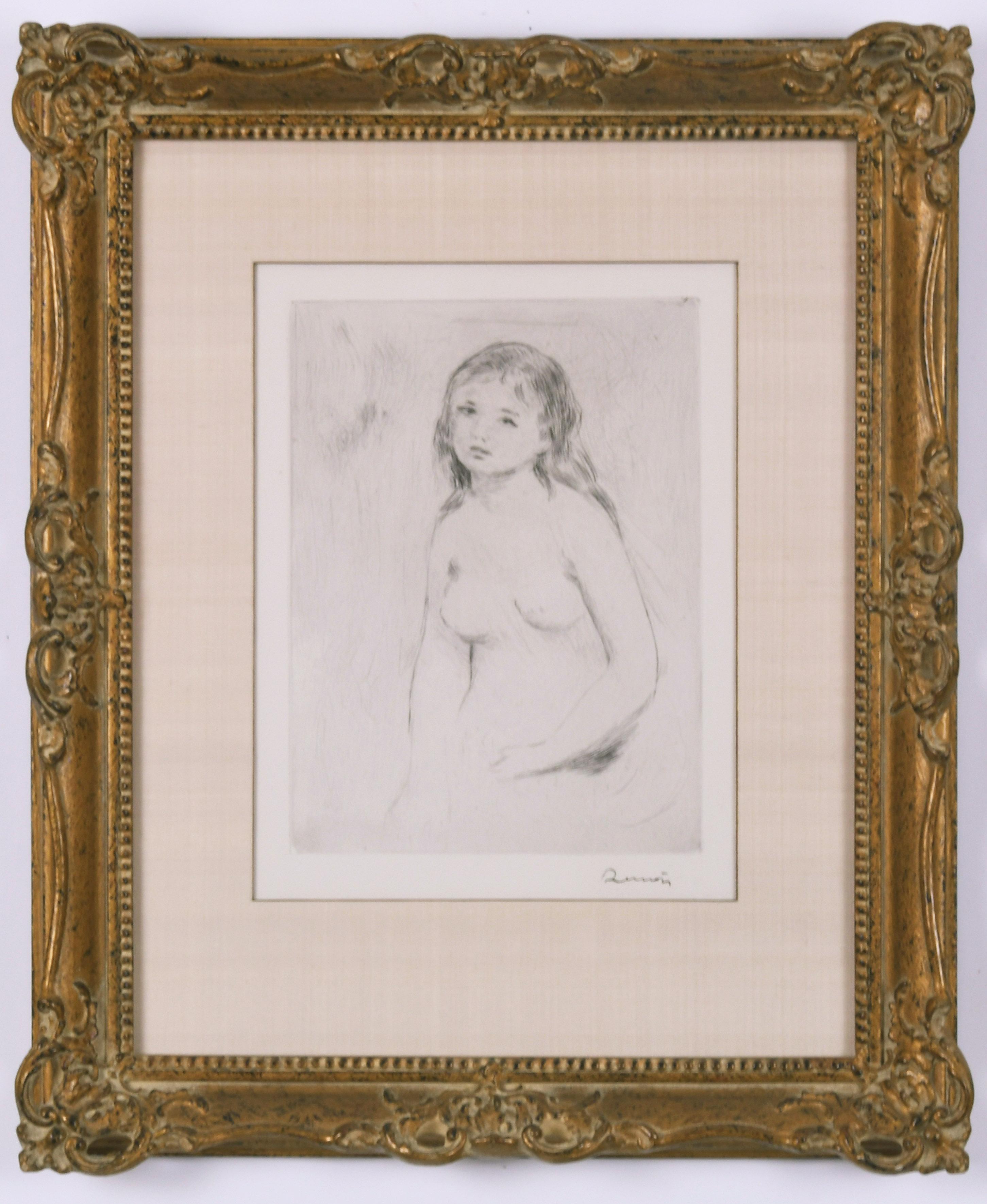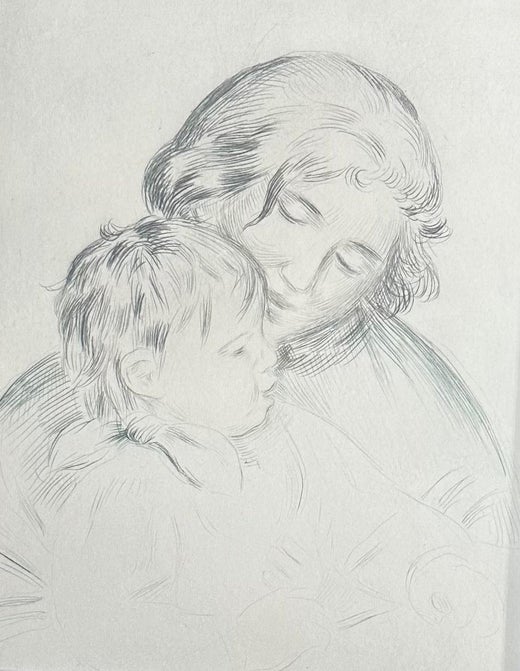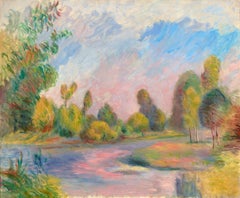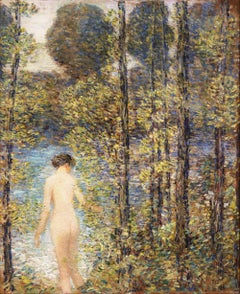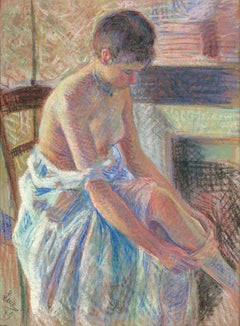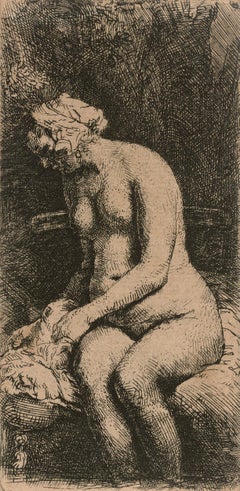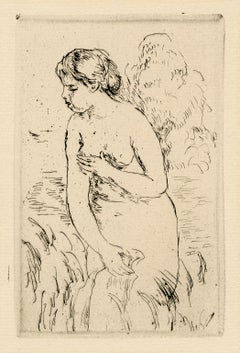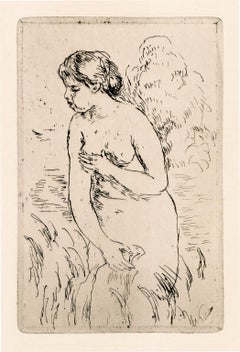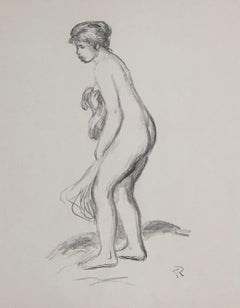Items Similar to Après le bain (After the bath)
Want more images or videos?
Request additional images or videos from the seller
1 of 8
Pierre Auguste RenoirAprès le bain (After the bath)Circa 1898
Circa 1898
Price Upon Request
Price Upon Request
Price Upon Request
Price Upon Request
Price Upon Request
Price Upon Request
Price Upon Request
Price Upon Request
Price Upon Request
Price Upon Request
About the Item
For Pierre-Auguste Renoir, Impressionism's pre-eminent figure painter, depicting the nude was an exercise in bringing the canvas to life. He once said, “I look at a nude, I see myriads of minuscule shades. I have to find those which will make the flesh on my canvas come to life and resonate.” This compelling portrait by Renoir entitled Après le bain presents the nude figure of a woman in a serene, private moment, absorbed in the task of drying herself after a bath. The artist’s mastery of light and shading is incredible, achieving a sense of vitality in this otherwise ordinary scene.
Renoir is celebrated for his figural work, especially his Rubenesque female nudes, however, it was not until the artist was in his forties that he depicted the nude with any frequency. In 1881, Renoir traveled to Italy, where he studied the works of the Renaissance masters and the ancient art of Pompeii and Rome. Upon his return to France, the nude became his favored subject, and he used the motif to combine the spontaneity of Impressionism with the solid modeling of classical painting. Renoir’s medium here, sanguine, a reddish-brown chalk, was used extensively in the Renaissance by Leonardo (who employed it in his sketches for the Last Supper), Michelangelo and Raphael. Its warm hue lends itself well to depicting flesh, and the chalk drawing allows for a greater focus on line, form and texture in a departure from the aspects of color and light that so often preoccupied the Impressionists. Après le bain conveys the impression of arrested motion with perfect naturalness, deftly capturing the moment before the elegant lines of the sitter's form change position.
The sitter is almost certainly Gabrielle Renard, the nanny to Renoir’s children and a frequent model for the artist. Gabrielle was the cousin of Renoir’s wife, Aline, and came to Montmartre to work for the family at the age of 16. She developed a strong bond with the family and became a favorite subject for Renoir, appearing in several of his most important works, including his 1911 Gabrielle with a Rose (Musée d'Orsay). When Renoir began to suffer from severe rheumatoid arthritis that would eventually leave him unable to walk and scarcely able to grasp a paintbrush, it was Gabrielle that would assist the artist by positioning the paintbrush between his crippled fingers.
Born in Limoges, France in 1841, Renoir began his career as an apprentice to a painter of porcelain wares. He later moved to Paris at the age of 21, enrolling at the prestigious École des Beaux-Arts. It was here, while studying under Charles Gleyre, that Renoir attained a tremendous appreciation for the academic style of painting, a quality that would last throughout his career. This was also when he met Claude Monet and several other classmates, with whom he would later form the Impressionists.
Working closely with Monet, Renoir began experimenting with the portrayal of light and its effect on his canvases. The youngest member of the Impressionist movement, an astute Renoir recognized how a subject was constantly changing due to the dynamic effects of light on color. Relying heavily upon his academic training that focused on composition, lines and descriptive details, Renoir distinguished himself among his contemporaries. His intuitive use of color and expansive brushstroke, along with acute attention to his subject, have placed him among the finest painters in history.
This work is accompanied by a certificate of authenticity and will be included in the forthcoming catalogue raisonné of the work of Pierre-Auguste Renoir from the Wildenstein Plattner Institute.
Circa 1898
Canvas: 43 1/2" high x 35 1/2" wide
Frame: 57 3/4" high x 49 1/4" wide
Provenance:
Galerie Durand-Ruel, Paris (acquired from the artist on January 25, 1899)
J. Pereire Collection, France (1966)
Sam Salz, New York (before 1981)
Claus Virch, Paris
French Compagny, Inc., New York
Larry Silverstein, New York (circa January 1987)
Le Clos de Sierne Gallery, Geneva
Galerie Heyram, Paris (October 1987)
Francis Gross
M.S. Rau, New Orleans
Literature:
B. Schneider, Renoir, Berlin, 1957, p. 95 (illustrated in color, p. 83)
M. Gauthier, Renoir, Paris, 1958, p. 83 (illustrated in color; erroneously dated '1916' and titled 'Woman in her toilet')
F. Fosca, Renoir, L'homme et son obra, Paris, 1961, p. 280 (illustrated, p. 95; erroneously dated 'about 1890' and titled 'After the Bath')
G.-P. and M. Dauberville, Renoir, Catalog raisonné des tableaux, pastels, dessins et aquarelles, Paris, 2010, vol. III, p. 515-516, no. 2597 (illustrated, p. 515)
Exhibited:
Galerie Durand-Ruel, Paris, Watercolors, Pastels and Drawings by Renoir, April 1921, p. 3, no. 53 (erroneously dated '1906' and titled 'Baigneuse s'essuie').
Kunsthalle, Basel, Meisterzeichnungen französischer Künstler von Ingres bis Cézanne , June-August 1935, p. 30, no. 223.
Galerie des Beaux-Arts, Paris, Exhibition of “La Gazette des Beaux-Arts”, Renoir, The sculpted work, the engraved work, watercolors and drawings, October-November 1935, p. 30, no. 22.
Musée national d'art moderne, Paris, From Impressionism to the present day , June 1958, no. 175 (illustrated, pl. 9).
The Metropolitan Museum of Art, New York, 1966-1973.
- Creator:Pierre Auguste Renoir (1841 - 1919, French)
- Creation Year:Circa 1898
- Dimensions:Height: 57.75 in (146.69 cm)Width: 49.25 in (125.1 cm)
- Medium:
- Movement & Style:
- Period:
- Condition:
- Gallery Location:New Orleans, LA
- Reference Number:Seller: 31-37931stDibs: LU1869325482
Pierre Auguste Renoir
Pierre-Auguste Renoir had his first experience with art in 1845 at the age of 4 when his family moved to Paris from Limoges and settled near the Louvre. By the age of 13, he had begun to seriously study and practice his work. Renoir started as an apprentice painter in a porcelain factory, where he spent five years. He then took drawing lessons from Charles Gleyre and in 1862, when he was 21; Renoir attended the Ecole des Beaux-Arts. It was at the National School of Fine Arts in Paris where Renoir met the future founders of Impressionism, Claude Monet, Alfred Sisley, and Frederic Bazille. Renoir paintings remained in the traditional style during the 1860s. His portrait of his mistress, Lise Trehot, was traditional enough to be accepted for the 1867 Salon. Pierre Auguste Renoir’s paintings began to change shortly after he moved in with Claude Monet and Frederic Bazille in 1869. Renoir updated his technique and color scheme. Renoir painted mostly outdoors and began to use vibrant, pure colors and little brush strokes. Renoir, along with Claude Monet, Camille Pissarro, and Alfred Sisley was part of the first exhibition of the Society of Independent Artists in 1874. It was at this exhibit that the term “Impressionism” was first used. The term was coined by a French art critic who took the name from a Monet painting. The term was meant to be derogatory and the show was a financial failure. Despite the failure, the artists continue to exhibit together and were joined by Edgar Degas and Georges Seurat. By the early 1880s, the public had begun to recognize the importance of the Impressionists’ work. In the early 1880s, Renoir traveled and painted extensively. He held his first one-man exhibition in 1883 in Paris. He received commissions from prominent Parisians and painted numerous group portraits of his friends, writers, and fellow artists. By 1887, Renoir was famous and donated several paintings to Queen Victoria for her Golden Jubilee. By the time he was 50, Renoir’s health began to decline. He suffered from cataracts, rheumatoid arthritis, and ankyloses, and spent the last twenty years of his life confined to a wheelchair. During this time he continued to paint and even took up sculpting.
About the Seller
5.0
Vetted Professional Seller
Every seller passes strict standards for authenticity and reliability
Established in 1912
1stDibs seller since 2013
18 sales on 1stDibs
Typical response time: 10 hours
- ShippingRetrieving quote...Shipping from: New Orleans, LA
- Return Policy
Authenticity Guarantee
In the unlikely event there’s an issue with an item’s authenticity, contact us within 1 year for a full refund. DetailsMoney-Back Guarantee
If your item is not as described, is damaged in transit, or does not arrive, contact us within 7 days for a full refund. Details24-Hour Cancellation
You have a 24-hour grace period in which to reconsider your purchase, with no questions asked.Vetted Professional Sellers
Our world-class sellers must adhere to strict standards for service and quality, maintaining the integrity of our listings.Price-Match Guarantee
If you find that a seller listed the same item for a lower price elsewhere, we’ll match it.Trusted Global Delivery
Our best-in-class carrier network provides specialized shipping options worldwide, including custom delivery.More From This Seller
View AllAu Bord De La Rivière By Pierre-Auguste Renoir
By Pierre-Auguste Renoir
Located in New Orleans, LA
Pierre-Auguste Renoir
1841-1919 French
Au bord de la rivière
(Along the River)
Oil on canvas
"Renoir may be the only great painter who has never painted a sad picture."
- Octave ...
Category
19th Century Impressionist Landscape Paintings
Materials
Canvas, Oil
The Bather by Childe Hassam
By Childe Hassam
Located in New Orleans, LA
Childe Hassam
1859-1935 American
The Bather
Signed and dated “Childe Hassam” (lower right)
Oil on canvas
Considered by many to be America’s foremost Impressionist painter, Childe Hassam composed his tranquil and intimate oil on canvas The Bather in the early years of the 20th century. The creation of the artwork aligns with a period of Hassam’s career where the artist’s palette was transforming, matching ever closer with the pale and pastel hues of French Impressionists like Claude Monet. Even the subject — a nude woman — represents a greater alignment with the Impressionist project, as artists of the movement and their non-mythological and non-biblical nudes still generated cries of indecency. With Hassam’s signature brushwork and attention to color, The Bather serves as a dream-like vision, serene and sensuous, of a young woman bathing in a lush forest.
While the artist's skill for landscape painting is on display, it is Hassam's command of form, light and color that brings this canvas to life. He creates a captivating composition, placing the nude subject in the bottom left of the canvas. The soft, undulating curves of the woman's body in contrapposto and the glow of her fair skin are balanced by the strong verticals and deep earth tones of the tall trees to her right. Hassam delicately frames the nude in the vivid blues of the distant water, building luminous color that further draws the viewer’s eye and results in a somewhat voyeuristic appeal — endowing his nude with both a natural innocence and an intentional sensuality.
Born in Dorchester, Massachusetts, Childe Hassam began his artistic career as a freelance illustrator, working for national publications such as Harper’s Weekly, Scribner’s Monthly, and The Century. His first solo exhibition of watercolors took place in Boston in 1883, and he quickly catapulted onto the international scene, winning a bronze medal at the Exposition Universelle in Paris in 1889. The year before the present work was created, he received the Webb Prize from the Society of American Artists for another landscape painted at Gloucester. Hassam would receive numerous other awards throughout his career, most notably the Gold Medal for Distinguished Services to Fine Art from the American Dealers Association. A true master, Hassam depicted a way of life characteristic of both American and French society, and his work elucidates a critical chapter in American art history. Today, his work resides in the Oval Office of the White House and in numerous important museums, including the Metropolitan Museum of Art in New York, the National Gallery of Art in Washington, DC and the Museum of Fine Arts in Boston, among others.
This painting will be included in Stuart P. Feld's and Kathleen M. Burnside's forthcoming catalogue raisonné of the artist's work.
Circa 1905
Canvas: 24 1/2“ high x 20 18” wide
Frame: 35 7/8“ high x 31 1/4” wide x 3 1/4“ deep
Provenance:
Private Collection of William Young...
Category
20th Century Impressionist Nude Paintings
Materials
Canvas, Oil
Femme mettant ses bas by Maximilien Luce
By Maximilien Luce
Located in New Orleans, LA
Maximilien Luce
1858-1941 French
Femme mettant ses bas
(Woman putting on her stockings)
Pastel on paper
Signed "Luce 89" (lower left)
Maximilien Luce’s Femme mettant ses bas is a...
Category
19th Century Post-Impressionist Figurative Drawings and Watercolors
Materials
Paper, Pastel
Woman Bathing Her Feet in a Brook by Rembrandt van Rijn
By Rembrandt van Rijn
Located in New Orleans, LA
Rembrandt van Rijn
1606-1669 Dutch
Woman Bathing Her Feet in a Brook
Etching on paper
New Hollstein's 309, second state of II
Signed and dated "Rembrandt f. 1658" (upper left)
Created from observations of a live model, this work started as a figure study before evolving into a more imaginative setting. It remains ambiguous whether the scene is set indoors, as suggested by the cushion the figure is seated on, or outdoors, indicated by the foliage in the background. The omission of her feet, suggesting they may be dangling in a brook, adds a charming touch to Rembrandt’s imaginative scene. The figure seems unaware of the viewer, presenting a dignified yet sensual demeanor.
The son of a miller, Rembrandt van Rijn is believed to have been born in Leiden on July 15, 1606. He studied first at the Latin School and then was enrolled at the University of Leiden at the age of 14. He soon left to study art—first with a local master, Jacob van Swanenburch, and then, in Amsterdam, with Pieter Lastman...
Category
17th Century Old Masters Figurative Drawings and Watercolors
Materials
Etching, Paper
Danseuse By Pierre Carrier-Belleuse
By Pierre Carrier-Belleuse
Located in New Orleans, LA
Pierre Carrier-Belleuse
1851-1932 French
Danseuse
Signed “Pierre Carrier-Belleuse” (lower right)
Pastel on canvas
Strikingly elegant, this extraordinary pastel by French impressi...
Category
19th Century Impressionist Figurative Drawings and Watercolors
Materials
Canvas, Pastel
Nu tenant un miroir by Pablo Picasso
By Pablo Picasso
Located in New Orleans, LA
Pablo Picasso
1881-1973 Spanish
Nu tenant un miroir
(Nude holding a mirror)
Signed "Picasso" (lower right)
Pen and ink on paper
Pablo Picasso's Rose Period is among the most icon...
Category
Early 20th Century Nude Drawings and Watercolors
Materials
Paper, Ink, Pen
You May Also Like
Baigneuse Debout, à Mi-Jambes — French Impressionism
By Pierre-Auguste Renoir
Located in Myrtle Beach, SC
Pierre Auguste Renoir, 'Baigneuse Debout, à Mi-Jambes (Woman Bathing, Standing Up to Her Knees in Water)', 1910, etching, edition not stated, Delteil 23. Unsigned as published. A fin...
Category
1910s Impressionist Nude Prints
Materials
Etching
'Baigneuse Debout, à Mi-Jambes' — French Impressionism
By Pierre-Auguste Renoir
Located in Myrtle Beach, SC
Pierre Auguste Renoir, 'Baigneuse Debout, à Mi-Jambes (Woman Bathing, Standing Up to Her Knees in Water)', 1910, etching, edition not stated, Delteil 23. Unsigned as published. A fin...
Category
1910s Impressionist Nude Prints
Materials
Etching
$600 Sale Price
20% Off
Pierre- Auguste Renoir, "Woman Bathing, Standing, Full Length Profile", litho
By Pierre-Auguste Renoir
Located in Chatsworth, CA
This piece is an original lithograph created by Pierre- Auguste Renoir in 1896. This piece was done in black on Arches Ingres laid paper. There is also an edition of 100 impression...
Category
18th Century Figurative Prints
Materials
Lithograph
Auguste Renoir"s last student: impressionist female nude the Statuesque Bather
By Lucien Boulier
Located in Norwich, GB
If something about this painting seems familiar, it is for good reason! Dating from circa 1905-10, it is a work by Lucien Boulier (1882-1963), who was effectively Renoir's last stude...
Category
Early 20th Century Impressionist Figurative Paintings
Materials
Canvas, Oil
Baigneuse debout à mi-jambes
By Pierre Auguste Renoir
Located in Santa Monica, CA
PIERRE-AUGUSTE RENOIR (French, 1841 - 1919)
BAIGNEUSE DEBOUT A MI JAMBES (D., S. 23)
Etching, 1910, a later impression on laid paper, the only state. Full margins with deckle edge...
Category
1910s Impressionist Figurative Prints
Materials
Etching
$760 Sale Price
20% Off
Etude pour une baigneuse (Study for a Bather)
By Pierre Auguste Renoir
Located in Fairlawn, OH
Etude pour une baigneuse (Study for a Bather)
Drypoint, 1901-1911
Signed with the signature stamp, Lugt 2137a
Printed: Louis Fort, Paris
Publisher: Ambrose Vollard, Paris
"The fame o...
Category
Early 1900s Impressionist Nude Prints
Materials
Drypoint
Read More
Paul Revere Crafted This Silver Coffee Pot 250 Years Ago
Perhaps best known as a Revolutionary War hero, Revere was also an accomplished silversmith, and this pot is now available on 1stDibs.
Degas Portrayed These Exuberant Ukrainian Dancers with ‘Orgies of Color’
Discovered in Parisian cabarets, the performers reenergized the artist’s practice.
